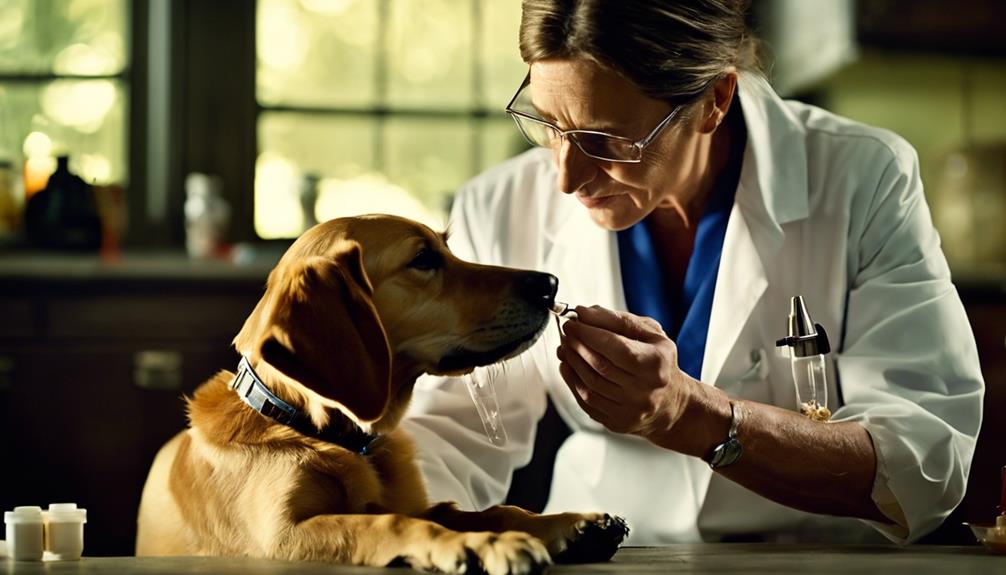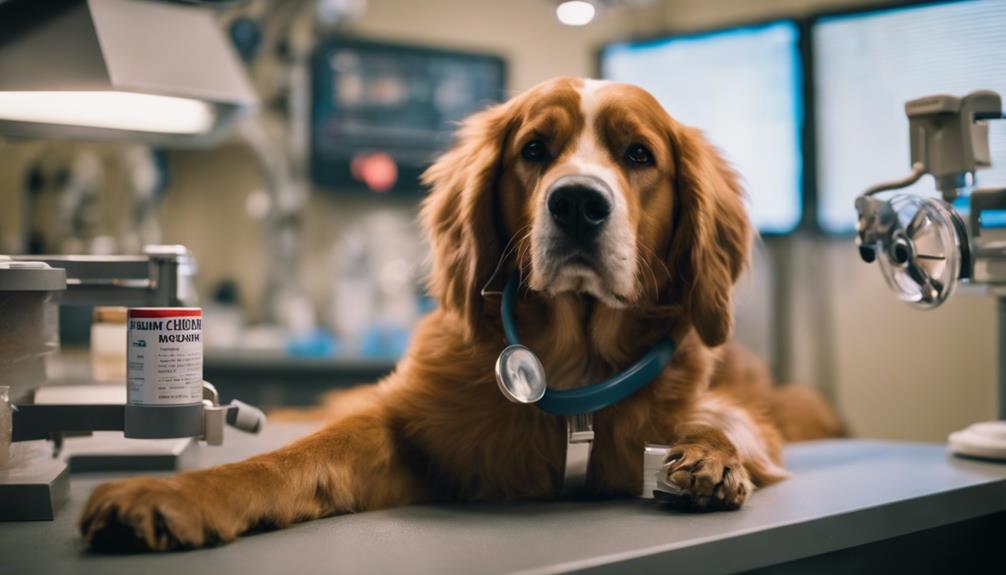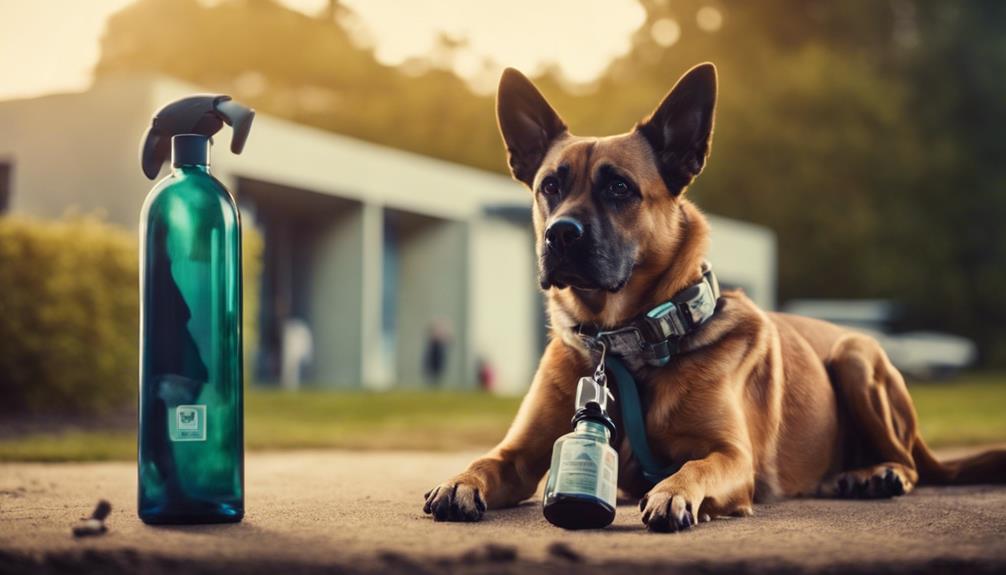Simethicone for Dogs: Uses, Dosage, Side Effects
Simethicone is a vital treatment for dogs who are struggling with gas problems. It works by combining smaller gas bubbles into bigger ones, making it easier for dogs to pass them. This medication is sold under names like Gas-X and Mylicon and comes in both chewable tablets and liquid forms.
Dosing is key and must be tailored to the dog’s weight, usually falling in the range of 1-2 mg per pound of the dog’s body weight, administered three times a day. While it’s highly effective, it’s not without its side effects, which may include diarrhea, nausea, and vomiting. On rare occasions, dogs might have an allergic reaction to it, noticeable by symptoms like hives or difficulty breathing.
It’s always a smart move to talk to a vet before starting your dog on simethicone. This ensures the treatment is both safe and suited to your dog’s specific needs. Paying attention to the correct dosage and being aware of possible side effects can make a big difference in how well your dog responds to treatment.
Key Takeaways
- Simethicone eases dog gas by merging bubbles.
- Dosage ranges from 20 mg to 80 mg depending on size.
- Side effects can include diarrhea and allergic reactions.
Understanding Simethicone
Simethicone is a key treatment for dogs suffering from gas. It works by combining smaller gas bubbles into larger ones in the digestive system, making them easier for the dog to pass. This can significantly reduce discomfort and bloating for your pet.
However, while Simethicone is effective, it’s critical to watch out for possible side effects such as diarrhea, nausea, and vomiting, which could indicate that the medication isn’t agreeing with your dog.
Always talk to your vet before giving Simethicone to your dog. They can advise on the right dose and how to administer it safely, ensuring it meets your dog’s specific health needs. This careful approach helps avoid any complications and ensures your dog gets the relief they need from gas and bloating.
Common Brand Names

When looking for simethicone products for dogs, there are several well-known brands to consider. Gas-X, Alka-Seltzer Anti-Gas, and Mylicon stand out as top picks. They offer a variety of forms, such as chewable tablets and liquids, making it easy to find something that fits your dog’s needs.
These brands come in various strengths and dosages. It’s always a good idea to talk with your vet to pick the best simethicone option for your dog’s digestive health. This ensures your pet gets the right treatment for their specific condition.
Popular Veterinary Brands
Several veterinary brands like Gas-X, Alka-Seltzer Anti-Gas, Mylanta Gas, Phazyme, and Mylicon have developed simethicone-based products specifically for dogs to help with excessive intestinal gas issues. These names are trusted in the veterinary field for their effective and safe treatments, available in forms such as capsules, tablets, chewable tablets, oral liquids, and oral disintegrating strips. These products are designed to ease discomfort, pain, bloating, burping, and flatulence by changing the surface tension of gas bubbles, making them easier to break down and pass.
These options ensure that dog owners can choose the best form of administration for their pet’s preferences and needs, leading to better management of gastrointestinal discomfort linked to gas. The safety of these products is well-regarded across a wide range of canine patients, including those with special conditions, making them a go-to solution for many pet owners looking for relief for their dogs.
Medication Availability
When dealing with excessive intestinal gas in dogs, several treatment options are widely recommended due to their effectiveness. Brands like Gas-X, Alka-Seltzer Anti-Gas, Mylanta Gas, Mylicon, and Phazyme are often suggested because they’re easy to find and work well. The key ingredient in these products is simethicone. This is available in many forms, including capsules, tablets, chewable tablets, liquid, and dissolving strips, making it easier to give to your dog based on their liking.
Simethicone works by changing the surface tension of gas bubbles in the intestines, which helps break them down and allows your dog to pass gas more comfortably. While simethicone is a popular choice for treating bloating, discomfort, and flatulence in dogs, it’s always best to talk to a vet before starting treatment. This ensures the treatment is safe and suitable for your dog, especially since side effects like diarrhea and lethargy can occur.
Indications for Use

Simethicone is often the go-to solution for dogs suffering from uncomfortable gastrointestinal issues caused by too much intestinal gas. This can lead to symptoms like bloating, pain, and a lot of gas. The medicine works by changing how gas bubbles interact, making it easier for the gas to pass and reducing discomfort. It’s crucial to talk to a vet before giving simethicone to your dog to ensure it’s suitable for their particular symptoms.
Vet Consultation is key to figuring out the right dosage and if it’s the right choice for your pet’s health issue. Symptoms to watch out for include a lot of gas, burping, and abdominal pain. These are signs that simethicone might help.
The way simethicone works is pretty straightforward. It helps small gas bubbles come together to form bigger ones. This makes it easier for dogs to get rid of gas, helping them feel better faster.
Recommended Dosages

Choosing the right dosage of simethicone for dogs depends on the dog’s weight and health issues. For smaller dogs, the dose starts at 20 mg and can go up to 80 mg for bigger dogs. This varies with how severe the symptoms are.
Always talk to a vet to get the dose just right, ensuring your dog’s safety and the treatment’s effectiveness.
Dosage Guidelines
When giving simethicone to dogs, it is vital to adhere to dosage guidelines to ensure both effectiveness and safety. Proper dosing is key to safely using simethicone and helps it work better by breaking down gas bubbles in the dog’s stomach.
Always check with your vet to get the right dosage for your dog’s size and specific needs.
For treating gas, give your dog 1-2 mg of simethicone per pound of body weight, three times daily.
If you think your dog might be experiencing bloat, give two doses right away and get to a vet quickly.
Sticking to these recommendations keeps the treatment both effective and safe for your pet.
Adjusting Dosages Safely
Adjusting simethicone dosages for dogs is crucial, considering their size and how much they’re affected by gas problems. Dosage recommendations change significantly from 20 mg for smaller breeds, 40 mg for medium-sized ones, to 80 mg for the larger buddies. This variation underscores the necessity of matching the dosage to the dog’s weight.
Veterinarians are key in setting the right dose for each dog, considering both the pet’s weight and how severe their gas issues are. Getting the dosage right is essential for safely managing these uncomfortable symptoms. Always talk to a vet before changing your dog’s simethicone dosage to make sure it’s the right move for their health and happiness.
Administration Methods

When giving Simethicone to dogs to ease their gas discomfort, it’s crucial to pick the right form of this medication, such as liquid, tablets, capsules, or syrup. This choice ensures the treatment is both effective and comfortable for the pet. The liquid version is often preferred because it’s easier to give to dogs who might not like swallowing pills.
For dogs that have trouble swallowing, tablets and capsules can be crushed or mixed into their food. This method makes it simpler for them to take their medicine without stress. Syrup options are great for precise dosing based on the dog’s weight, making the treatment more effective.
Ensuring you use the right method to administer Simethicone helps manage gas discomfort in dogs effectively. This approach supports their wellbeing by providing relief from their symptoms.
Possible Side Effects

Simethicone is usually safe for dogs, but it can have side effects. Watch out for signs like diarrhea, nausea, vomiting, and tiredness.
There might also be serious allergic reactions such as skin rashes, swelling, or trouble breathing. If your dog shows any of these signs, especially after an overdose, seeing a vet quickly is key to managing these problems well.
Common Side Reactions
Using simethicone for gas relief in dogs is generally safe, but it’s smart to watch for side effects. Common issues might include diarrhea, nausea, vomiting, and feeling tired. These symptoms are usually not serious but show the medication is affecting your dog.
If your dog shows intense signs of stomach upset, like a lot of diarrhea or vomiting, this could mean there’s a more serious problem that needs checking out. Feeling unusually tired is also a concern and might mean your dog isn’t reacting well to the treatment. If these symptoms don’t go away or get worse, it’s critical to contact your vet right away. This could mean an allergic reaction or too much medication, which can be dangerous.
Allergic Reaction Risks
Though it’s not common, dogs can have allergic reactions to simethicone. Signs to watch for include hives, swelling, or trouble breathing, which all require quick action and a visit to the vet to avoid serious problems.
Simethicone is usually safe for dogs, but owners should keep an eye out for any unusual reactions such as diarrhea and vomiting. If you think your dog has had too much simethicone, it’s critical to get veterinary help right away. Keeping a close watch for any allergic signs is key when giving simethicone to ensure any issues are caught and dealt with quickly.
This careful monitoring helps keep your dog comfortable and avoids major health problems from allergic reactions or too much medication.
Managing Adverse Effects
Managing the adverse effects of simethicone in dogs requires quick action and the right medical care. It’s crucial because simethicone helps break down gas bubbles in dogs, making it easier for them to pass or be absorbed. However, it’s essential to keep an eye out for any negative reactions.
Diarrhea and vomiting are common symptoms that might occur. These signs suggest the dog’s body is reacting to the change in gas tension. In such cases, ensuring the dog stays hydrated and receives supportive care is vital.
Allergic reactions such as hives or trouble breathing are serious. If these occur, stop giving the dog simethicone immediately and seek emergency vet care. Symptoms like restlessness, a swollen belly, and vomiting without producing anything could indicate a severe condition known as Gastric Dilation-Volvulus, which is life-threatening and requires immediate medical attention.
In handling these situations, the goal is to protect the dog’s health. Quick recognition of symptoms and timely veterinary care can make a significant difference. It’s about being proactive and responsive to the needs of our canine companions.
Drug Interactions

Simethicone, often used to relieve gastrointestinal discomfort in dogs, can interact with specific medications like levothyroxine, a common thyroid treatment. This combination can affect how well the thyroid medication works, leading to potential issues in managing thyroid conditions in our canine companions.
It’s essential for dog owners to tell their vets about all the medications their pet is taking. This allows the vet to check for any drug interactions and adjust the treatment plan if necessary, ensuring the dog stays healthy and happy.
Special Precautions

When giving simethicone to dogs, it’s critical to prioritize their health and safety. Simethicone helps ease gas by breaking up big gas bubbles in the gut.
Always get a vet’s approval before giving simethicone to your dog. This step is essential to prevent any harm from incorrect dosages or unnecessary treatment. Watch out for signs of severe conditions like restlessness, a bigger belly, and vomiting without any output. These could be signs of Gastric Dilatation-Volvulus (GDV), a deadly condition.
Be extra careful if your dog is pregnant or nursing. Since there’s limited information on how simethicone affects these dogs, consulting your vet first is the safest route.
Observing Response to Treatment

Monitoring how your dog reacts to simethicone for gas discomfort is key to understanding if it’s working. Watch for changes in symptoms like too much gas, burping, and a swollen belly as signs of improvement.
It’s also crucial to look out for any negative reactions, such as diarrhea or throwing up, which might mean the treatment needs to be tweaked. Serious side effects like hives, swelling, or breathing issues demand immediate action from a vet to avoid bigger health problems.
If gas issues don’t improve or get worse, it could signal a deeper health issue, so getting veterinary advice is necessary to update the treatment approach. This ensures your dog’s health is properly looked after.
When to Contact Your Vet

Monitoring your dog’s reaction to simethicone treatment is crucial, but it’s equally critical to know when it’s time to call the vet. Simethicone helps alleviate gas discomfort in dogs by breaking up gas bubbles in their stomach and intestines. However, it can sometimes cause negative reactions or point to more serious health issues.
If your dog starts experiencing diarrhea, vomiting, or seems unusually tired after taking simethicone, it’s important to get in touch with your vet. A suspected overdose of simethicone is a medical emergency that requires immediate veterinary care to avoid potential harm. Also, if your dog shows signs of an allergic reaction like hives, facial swelling, or has trouble breathing, or if you notice symptoms of a severe condition such as GDV (characterized by restlessness, a swollen belly, or attempts to vomit without bringing anything up), these are clear indicators that your pet needs urgent veterinary attention.
Before giving simethicone to your dog, make sure to discuss it with your vet to ensure it’s a safe and effective option for your pet’s specific needs.
Frequently Asked Questions
Can Simethicone Be Used as a Preventative Measure for Gas in Dogs, or Is It Only for Treating Symptoms After They’ve Appeared?
- Simethicone treats, not prevents, dog gas.
- Diet and exercise help avoid gas.
- Act before symptoms appear for best results.
How Does Simethicone in Dogs Affect Their Long-Term Digestive Health?
- Digestive flora impacts could need more study.
- Nutritional changes might be necessary for health.
- Regular exercise remains crucial for well-being.
Are There Any Breed-Specific Considerations When Using Simethicone for Dogs?
- Breed research is key for safe simethicone use in dogs.
- Weight-based dosing ensures drug effectiveness and safety.
- Custom treatments benefit specific dog breeds most.
Can Simethicone Be Safely Administered to Pregnant or Nursing Dogs?
- Consult a vet before giving simethicone to pregnant dogs.
- Ensures mother and puppies’ health.
- Addresses lactation nutrition effectively.
How Does Simethicone Interact With Natural or Homeopathic Remedies for Gas in Dogs?
- Simethicone’s effects with herbal remedies in dogs lack research.
- Compatibility with natural treatments needs careful consideration.
- Evidence on synergistic or antagonistic reactions is scarce.
